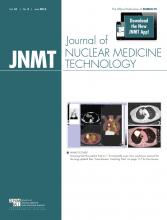
Norman E. Bolus, MSPH, MPH, CNMT, FSNMMI-TS
I am pleased to announce a new JNMT feature, in collaboration with the SNMMI Academic Council, called Teaching Case Studies. The intent of this feature is to allow an ongoing avenue for case studies to possibly be published in the journal or featured in the Teaching Case Studies section at the bottom of the home page of the SNMMI Web site. This effort will allow a case study to be published in JNMT if it passes a peer review process. If too many cases are submitted for journal inclusion or if the cases are not accepted through the peer review process they may still appear in the online library, which is archived. The hope is that over time a nice library of teaching cases will be available in the archive for all to use. Anyone can submit cases (student technologists, technologists, residents, physicians, clinicians) as long as they are in the proper format as indicated below:Teaching Case Studies should contain no more than 750 words; the 750-word limit includes all data, including title page, references, and legends describing the image findings. A maximum of 5 figures and 5 references is allowed, and the maximum number of authors is three. The objective of Teaching Case Studies is to present images that demonstrate key facts or concepts in clinical nuclear medicine and molecular imaging. Emphasis is placed on studies in which imaging has been useful in helping with the diagnosis. Teaching Case Studies will be accepted for publication in JNMT at the discretion of the Editor and may also be posted on the SNMMI Web site. Submissions not accepted for publication in JNMT may be accepted for posting on the SNMMI Web site only. Teaching Case Studies should be divided into 4 sections: an “Introduction” section briefly describing the point that the article is teaching, explaining the significance of the article, and summarizing its educational value; a “Case Report” section describing relevant medical history, laboratory findings, clinical course, procedures performed, and condition at last follow-up; a “Discussion” section describing any findings, differential diagnosis, and final diagnosis; and a “Conclusion” section summarizing the take-home teaching points.
Another new feature, if you have not yet discovered it, is the JNM and JNMT full-text mobile journal application created by SNMMI in conjunction with HighWire Press. Compatible with iOS devices (iPad, iPod Touch, and iPhone), the application is available for download at the iTunes App Store. SNMMI members and journal subscribers are able to download and use the application for free as a benefit of society membership and journal subscription, and nonmembers can download and access the application for no charge during an extended trial period. The SNMMI journal application provides users with the ability to download, search, view, and save abstracts and full-text articles, including publish-ahead-of-print articles. In addition to accessing the latest journal content both as full-text HTML and as PDF, users can access supplemental material, subscribe to and follow JNM- and JNMT-related news feeds, bookmark content, and share articles via email. For other mobile devices, SNMMI journals can be viewed through a mobile Web interface available at www.snmjournals.org.“I never teach my pupils, I only attempt to provide the conditions in which they can learn.”
―Albert Einstein
In this edition of JNMT, we again have two new continuing education articles, one on dose optimization and the other on glomerular filtration rate measurement. In addition, there are imaging articles on topics ranging from 18F-FDG oral administration to pediatric succimer dosing, optimized partial-volume-effect correction of 18F-FDG images, lymphoscintigraphy dose preparation, parathyroid pinhole imaging, and dopamine transporter scan artifacts from head tilt. There is a consensus paper on PET/MRI, two teaching files (which going forward will change to the new Teaching Case Studies described above), and a book review. In an effort to highlight continuing education articles, at the annual meeting of the SNMMI a new Editor’s Choice Award from JNMT will be given to one continuing education article from 2012. I am also interested in topics, themes, or ideas for continuing education articles. If you have a topic you would like to see as a continuing education article, please let me know.
Finally, go online (www.snm.org/facebook) for this month’s situational judgment, “What Should I Do If I Think a Clinically Significant Finding on a Scan Is Being Ignored by a Reading Physician?”







